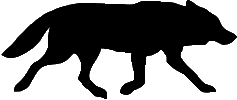Biology
Territoriality
The wolf is a territorial animal, in other words it defines, maintains and defend a territory in which it can satisfy all its needs and therefore carry out normal daily activities. In Italy its territories have an average size of 200-300 km² (77- 115 mi²) , but their size varies according to the type of occurring environment, in fact it appears to be inversely proportional to the availability of food and is often limited by anthropic or physics barriers.
The territory is generally chosen by the pack on the basis of its potential resources and then defended from the wolves of other packs through different strategies. Among these, the first to be used is certainly the odorous marking, made with faeces and urine, with which the wolves claim ownership of the territory but also communicate information about themselves, such as sex and rank. The howl is also used as a form of territorial communication.
If these bloodless mechanisms are not sufficient then the wolves can also pass to the physical confrontation, which can lead to the killing of the adversary, against specimens of other neighboring herds or solitary individuals of passage. Within its territory, each pack recognizes areas assigned for a specific purpose; in particular there are one or more dens traditionally used by the dominant female of the herd for the birth of puppies and meeting areas, called “rendez-vous sites”, where the herd gathers during the day or where the puppies are safely left during adult night hunts.
Ultimately, by obtaining the distribution of the packs in space, we can say that territoriality is in fact one of the mechanisms for regulating populations.
History
Population dynamics
Taking into consideration the factors that determine the changes in the number of individuals, the demographic structure and the density of animal populations, an analysis that constitutes the subject of the study called “population dynamics” is easy to understand that the wolf population in Italy, as of other living things, it is influenced by many parameters. In particular it is evident that even if the number of wolves in our territory has been increasing in the last forty years, we must not think that it can is grow to infinity.
The size and the density of the population depends indeed on several factors: first of all on the prey abundance, furthermore on the fact that just the dominant couple of the pack reproduces and it happens only once a year, and at least because the female gives birth to 2 – 6 pups but not all of them will survive, because they are subject to a certain mortality rate in the earliest vital stage.
We must also consider that the wolves face many dangers during their life, especially during their dispersal periods, that means when they move away from the pack heading to unknown places in search of a partner and new territories.
They can indeed enter territories belonging to other packs and clash with their “legitimate owners”, even risking their lives; it can also happen that they cannot feed or they could get hit by a car, crossing all the many roads in our territory. Another frequent danger encountered by wolves, even during their pack life, is to get wounded during the hunt by wild animals (wild boar, roe deer etc.);
and the healing of such injuries in nature is not guaranteed.
But they are even more likely to be victims of human killings, through poaching with the use of traps, laces, poison and firearms.
